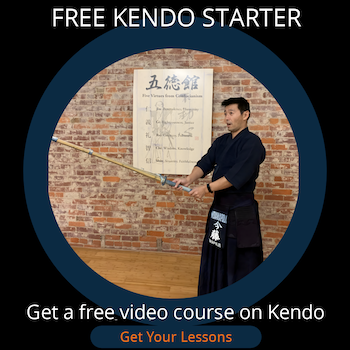Need Kendo Instructions?
You Got It!
You Got It!
What would be the translation for Musashi's "Five Approaches" in the Book of Water section of his Book of Five Rings?
by Keith
(Raleigh, NC, US)
I am very new to Kendo, and I am still trying to understand/contemplate the meanings in Musashi's teachings (which really led me to Kendo in the beginning).
In the Book of Water in the Book of Five Rings, Musashi discusses the "Five Approaches" of cutting, depending on the "attitude" taken in any particular instance at hand.
Musashi states that through the five methods, one will always win. However, several of the five methods involve cutting from below after a parried strike, and furthermore, he often discusses leaving the long sword in its downward (or parried) position, and then either cutting, or "scooping", up for a cut, when the opponent attempts a subsequent strike.
In modern Kendo, are correct cuts (or scoring points) ever made from a "cutting up" or "scooping" motion once the long sword has been parried or "dashed" into a downward position? And what target would one be aiming for?
I understand that during Musashi's time there probably weren't just the four target areas that we use today in modern Kendo and so I was just wondering as to the applicability of such strategy today.
Of course I am probably misunderstanding the principle Musashi is trying to portray in this area, but he puts such emphasis on these five approaches, that any correlation or understanding that is related to
Or even if it is not related to modern Kendo, but just to good or bad principles of cutting and strategy, any understanding would still be very useful.
Thank you very much, and thank you for providing so much information on your website and through your efforts. I live in the U.S. and there is a severe shortage of any information or guidance to Kendo usually available.
Answer: Thank you for your question. In kendo, we only have 4 targets and there are no cutting-up strikes.
I think the targets Musashi talks in his book can vary. He mentions some specific targets to cut in the book but the targets should vary; hand, arm pit, neck, body, shoulder, leg and so on. Basically, wherever opens, you go for it.
Since Book of Five Rings was written in old Japanese, there are various interpretations in even modern Japanese. So I suggest you should read more than one translated books.
We can learn a lot from those books written in the old days and actually these help us to improve our kendo.
If you are new to kendo, I strongly recommend learning kendo movements first. If you are lucky, you can learn kendo and classic style or koryū at the same time around where you live.
Hope this helps.

